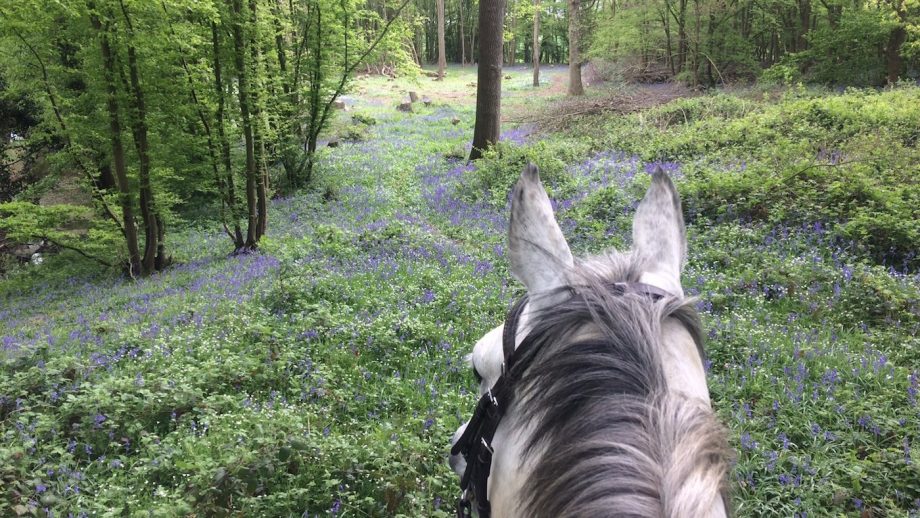The British Equestrian Trade Association has surveyed riders to find out the effect the past year has had on their riding, owning and spending. H&H finds out more, and what the industry can expect
PARTS of the equestrian industry appear to be emerging from the worst of the coronavirus pandemic in a better position than had been feared, research indicates.
The British Equestrian Trade Association (BETA) looked into how Covid had been affecting the horse world, from riding and horse-owning to spending and competing, in a similar manner to its four-yearly national equestrian survey.
{"content":"PHA+VGhlIHJlc2VhcmNoIGZvdW5kIHRoYXQgYWx0aG91Z2ggdGhlIG51bWJlciBvZiBwZW9wbGUgd2hvIGhhZCByaWRkZW4gaW4gdGhlIHBhc3QgeWVhciBoYWQgZHJvcHBlZCwgZnJvbSAzbSBpbiAyMDE4IHRvIDIuNW0swqAgYW5kIG9uZSBpbiAyMCByaWRlcnMgc3RvcHBlZCByaWRpbmcgYWx0b2dldGhlciBkdXJpbmcgdGhlIHBhbmRlbWljLCA1OSUgb2YgcmlkZXJzIHNhaWQgdGhleSBoYWQgYmVlbiBpbiB0aGUgc2FkZGxlIGFzIG11Y2ggYXMsIG9yIG1vcmUgdGhhbiwgcHJlLUNvdmlkIGxldmVscy4gT25lIGluIDEwIHJpZGVycyBoYXMgYmVlbiBzcGVuZGluZyBtb3JlIG9uIGVxdWVzdHJpYW4gaXRlbXMgZHVyaW5nIHRoZSBwYW5kZW1pYywgYW5kIHR3byBpbiAxMCBhIGxvdCBsZXNzLCBvciB0aGV5IGhhdmUgc3RvcHBlZCBzcGVuZGluZyBhbHRvZ2V0aGVyLCBidXQgdGhlcmUgaGFzIGJlZW4gYSAzOCUgaW5jcmVhc2UgaW4gb25saW5lIHNwZW5kLjwvcD4KPHA+QkVUQSBleGVjdXRpdmUgZGlyZWN0b3IgQ2xhaXJlIFdpbGxpYW1zIHRvbGQgPGVtPkgmYW1wO0ggPC9lbT5wZW9wbGUgaGFkIGJlZW4gdmVyeSB3b3JyaWVkIGFib3V0IHRoZSBpbXBhY3QgbG9ja2Rvd24gd291bGQgaGF2ZSBvbiB0cmFkZSwgYnV0IHRoZSBhc3NvY2lhdGlvbiBoYWQgaGVhcmQgYW5lY2RvdGFsIGV2aWRlbmNlIHRoYXQgdGhpbmdzIHdlcmUgbm90IGFzIGJhZCBhcyBoYWQgYmVlbiBmZWFyZWQuIFRoaXMgc3VydmV5IHdvdWxkIGNvbmZpcm0gb3IgZGlzcHJvdmUgdGhpcywgYXMgd2VsbCBhcyBhY3RpbmcgYXMgYSBtaWQtcG9pbnQgYmV0d2VlbiB0aGUgMjAxOCBhbmQgdGhlIDIwMjIgbWFqb3Igc3R1ZGllcy48L3A+CjxwPuKAnEl04oCZcyBub3QgYWxsIHJvc2VzIGJ1dCBJIHRoaW5rIHRoZSBpbmR1c3RyeSBpcyBjb21pbmcgb3V0IGJldHRlciB0aGFuIHdlIHRob3VnaHQgaXQgd291bGQsIGdvaW5nIGluLOKAnSBzaGUgc2FpZCwgYWRkaW5nIHRoYXQgdGhlIHR1cm4gdG93YXJkcyBvbmxpbmUgc2hvcHBpbmcgbWF5IGJlIGhlcmUgdG8gc3RheTsgNjUlIG9mIHJpZGVycyBzYWlkIHRoZXkgd2VyZSBsaWtlbHkgdG8gY29udGludWUgc2hvcHBpbmcgaW4gdGhpcyB3YXkuPC9wPgo8cD48ZGl2IGNsYXNzPSJhZC1jb250YWluZXIgYWQtY29udGFpbmVyLS1tb2JpbGUiPjxkaXYgaWQ9InBvc3QtaW5saW5lLTIiIGNsYXNzPSJpcGMtYWR2ZXJ0Ij48L2Rpdj48L2Rpdj48c2VjdGlvbiBpZD0iZW1iZWRfY29kZS0zMSIgY2xhc3M9ImhpZGRlbi1tZCBoaWRkZW4tbGcgcy1jb250YWluZXIgc3RpY2t5LWFuY2hvciBoaWRlLXdpZGdldC10aXRsZSB3aWRnZXRfZW1iZWRfY29kZSBwcmVtaXVtX2lubGluZV8yIj48c2VjdGlvbiBjbGFzcz0icy1jb250YWluZXIgbGlzdGluZy0tc2luZ2xlIGxpc3RpbmctLXNpbmdsZS1zaGFyZXRocm91Z2ggaW1hZ2UtYXNwZWN0LWxhbmRzY2FwZSBkZWZhdWx0IHNoYXJldGhyb3VnaC1hZCBzaGFyZXRocm91Z2gtYWQtaGlkZGVuIj4NCiAgPGRpdiBjbGFzcz0icy1jb250YWluZXJfX2lubmVyIj4NCiAgICA8dWw+DQogICAgICA8bGkgaWQ9Im5hdGl2ZS1jb250ZW50LW1vYmlsZSIgY2xhc3M9Imxpc3RpbmctaXRlbSI+DQogICAgICA8L2xpPg0KICAgIDwvdWw+DQogIDwvZGl2Pg0KPC9zZWN0aW9uPjwvc2VjdGlvbj48L3A+CjxwPlRob3NlIHdobyB3ZXJlIHNwZW5kaW5nIGxlc3MgY2l0ZWQgcmVkdWNlZCBpbmNvbWUgYW5kIHVuY2VydGFpbnR5IGFzIHRoZWlyIHJlYXNvbnMsIHdoaWxlIHRob3NlIHdobyB3ZXJlIHNwZW5kaW5nIG1vcmUgc2FpZCB0aGV5IGhhZCBtb3JlIG1vbmV5IGFzIHRoZXkgd2VyZSBub3QgY29tcGV0aW5nLCBvciBtb3JlIHRpbWUgYW5kIHNwYXJlIGNhc2ggdG8gcmV2aWV3IHRoZWlyIG5lZWRzLjwvcD4KPHA+TXMgV2lsbGlhbXMgc2FpZCB0aGUgcmlkaW5nIGZpZ3VyZXMgd2VyZSBub3QgdW5leHBlY3RlZDsgbWFueSBwZW9wbGUgd2VyZSB1bmFibGUgdG8gcmlkZSBkdXJpbmcgZnVsbCBsb2NrZG93biwgYnV0IG90aGVycyBoYWQgbW9yZSBmcmVlIHRpbWUgb3dpbmcgdG8gdGhlIGZ1cmxvdWdoIHNjaGVtZSBvciB3b3JraW5nIGZyb20gaG9tZS48L3A+CjxkaXYgY2xhc3M9ImFkLWNvbnRhaW5lciBhZC1jb250YWluZXItLW1vYmlsZSI+PGRpdiBpZD0icG9zdC1pbmxpbmUtMyIgY2xhc3M9ImlwYy1hZHZlcnQiPjwvZGl2PjwvZGl2Pgo8ZGl2IGNsYXNzPSJpbmplY3Rpb24iPjwvZGl2Pgo8cD7igJxXaGVuIHlvdSBwdXQgdGhlIOKAmG5vcm1hbOKAmSBmaWd1cmVzIGFnYWluc3QgbGFzdCB5ZWFy4oCZcywgdGhleeKAmXJlIGFjdHVhbGx5IG5vdCB0aGF0IGRpZmZlcmVudCzigJ0gc2hlIHNhaWQsIGFkZGluZyB0aGF0IG1vcmUgcGVvcGxlIGFnZWQgNDUrIGhhZCBzdG9wcGVkIHJpZGluZyBvciBkb25lIHNvIGxlc3MgZnJlcXVlbnRseSwgcG9zc2libHkgYXMgeW91bmdlciBwZW9wbGUgd2VyZSBob21lIGZyb20gc2Nob29sIG9yIHVuaXZlcnNpdHksIGFuZCBvbGRlciByaWRlcnMgbWF5IGhhdmUgYmVlbiBtb3JlIGxpa2VseSB0byBiZSBzaGllbGRpbmcgb3IgY29uY2VybmVkIGFib3V0IHRoZSB2aXJ1cy48L3A+CjxwPuKAnEJ1dCBpdOKAmXMgYSBwb3NpdGl2ZSBtZXNzYWdlLOKAnSBzaGUgc2FpZC4g4oCcQWZ0ZXIgdGhlIGZpcnN0IGxvY2tkb3duLCB0aGVyZSB3YXMgYSBuaWNlIGJvdW5jZSBiYWNrIHdoZW4gdGhlIHNob3BzIHJlb3BlbmVkLCBhbmQgcGVvcGxlIGxpa2Ugc2FkZGxlLWZpdHRlcnMgd2VyZSByZXBvcnRpbmcgaHVuZHJlZHMgb2YgcGVvcGxlIG9uIHdhaXRpbmcgbGlzdHMuIFRoaW5ncyBhcmUgZ29pbmcgdG8gZ2V0IGJhY2sgdG8gbm9ybWFsOyB3ZSBrbm93IHRoZXkgYXJlLuKAnTwvcD4KPHA+Cg=="}
You might also be interested in…
Credit: TI Media
Library image.
“This episode serves as a reminder of the importance of biosecurity, vaccination and having plans in place for protecting horses
Stay in touch with all the news in the run-up to and throughout the major shows and events during 2025 and beyond with a Horse & Hound subscription. Subscribe today for all you need to know ahead of these major events, plus online reports on the action as it happens from our expert team of reporters and in-depth analysis in our special commemorative magazines. Have a subscription already? Set up your unlimited website access now
H&H news editor
Eleanor is an experienced journalist who spent over eight years working for local and national newspapers before joining H&H as news editor in March 2016. Passionate about equine welfare and exposing the truth, Eleanor has reported on all aspects of the industry, from Brexit to anti-bullying campaigns, and from dressage rules to mules. Her sport of choice is showjumping, in which she competes her own horses, and she also enjoys reporting at local jumping shows through to international championships.





